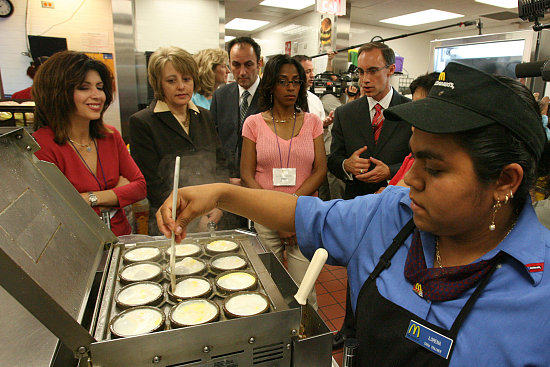
"Some women report finding the procedure uncomfortable."
Thus spoke the "reading material" provided by the Mammography clinic.
Whoa.... No kidding! Holding my breath to prevent chest movement, I was barely holding on to sanity for those few seconds my tit was being ground between two plates.
Looking at the images with the technician, I was interested to see the darker curve of muscle that formed an arc against the breast bone, next to which the fatty tissue of breast formed a lighter silhouette.
I queried the technician, "Do you think my pectoral muscles are big?"
"Oh, no, they're fine," was her jolly reply.
"But I work out!" I practically stamped my foot.
She tried gamely: "Oh, well, uh, you know, we see a lot of elderly, and they don't have any."
So that's that. One of the milestones of one's 40s, passed.
Gals, I recommend the bench press. Lie flat on your back, and push the bar straight up off your chest. No weights are necessary, the bare bar is 45 pounds and plenty to start with. Note: The photo on the page was the closest thing google image had of breast+pectoral muscles.
Now, there was one more note-worthy aspect of the trip to Brigham and Women's hospital for my first mammogram. When I checked in, they needed to update their records, and asked me two questions I've never been asked before at a doctor's office:
"Religious preference?"
"Atheist," I said automatically. The efficient clerk didn't bat an eye.
"Ethnicity? Like, you could say Irish, or Italian American."
She gave me choices so we'd both be done with a minimum of further explanation. And its pretty obvious to look at me that I'm from that tribe that took 10,000 years to get out of Central Asia.
"Northern European." She had no problem with that designation either.
But I had to wonder why these new questions. The ethnicity question could be part of medicine's gamble that persons whose ancestors originated in different geographical regions have slightly different susceptibility to diseases. For example, if your ancestors lived near the equator, they left you a nice ultraviolet radiation protection kit. Your doctor won't need to freeze off suspicious brown growths on your face, neck and shoulders (my Los Angeles living parents have to go through this a lot). In the U.S.A., if you have the appearance of being a member of an ethnic minority, the stress of guarding against negative evaluation (
"microaggresions") puts you at heightened risk of heart disease. So maybe this ethnic info helps --- but some critics say, medical profiling,
away. It leads doctors to zero in too quickly on the statistics specific to a certain group, as when a medical team missed a white kid's sickle cell anemia (specific case described in this
ppt).
But what about the religious question? Maybe doctors have learned that if someone is Buddhist, let them try temple healing first, given the power of placebo effects. And if someone's an atheist, just give 'em their options straight up, with statistics and empirical evidence laid out in all their glory.











